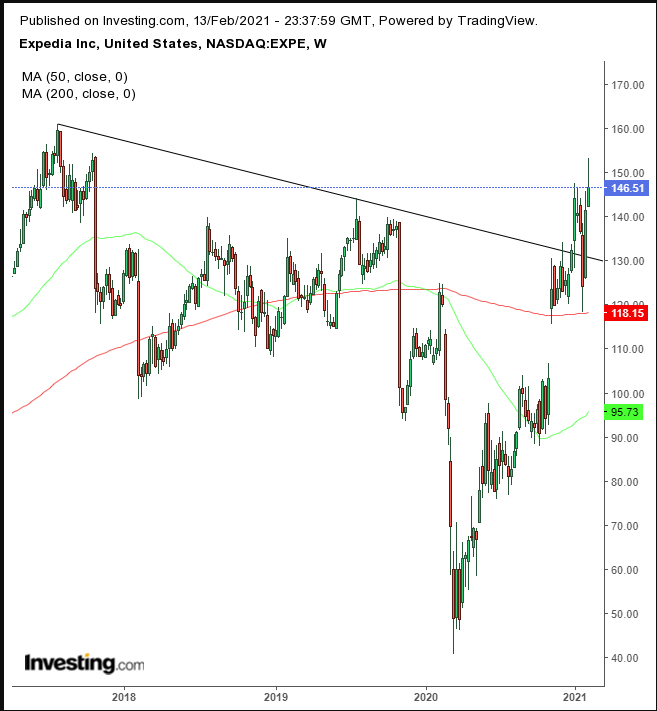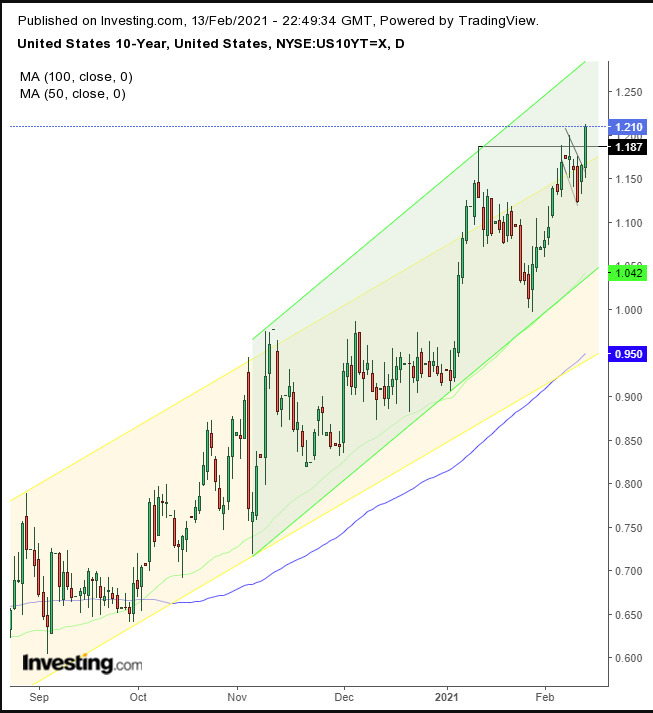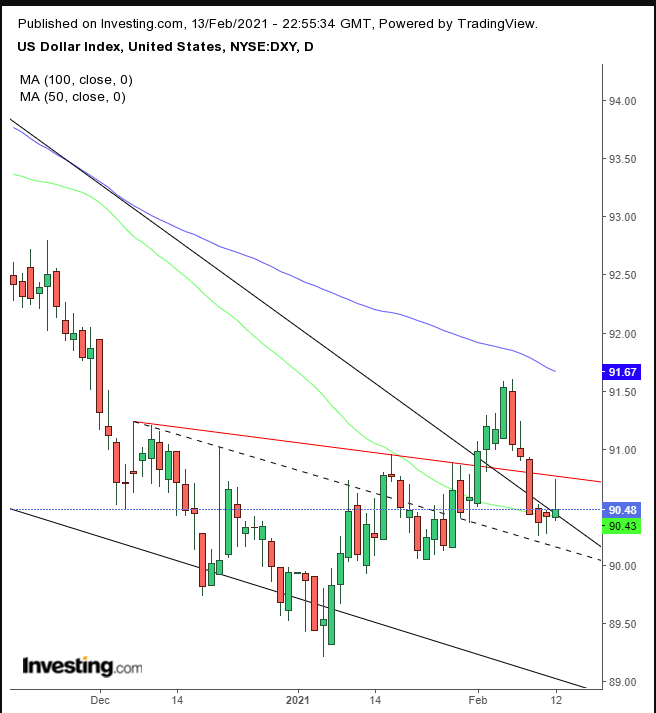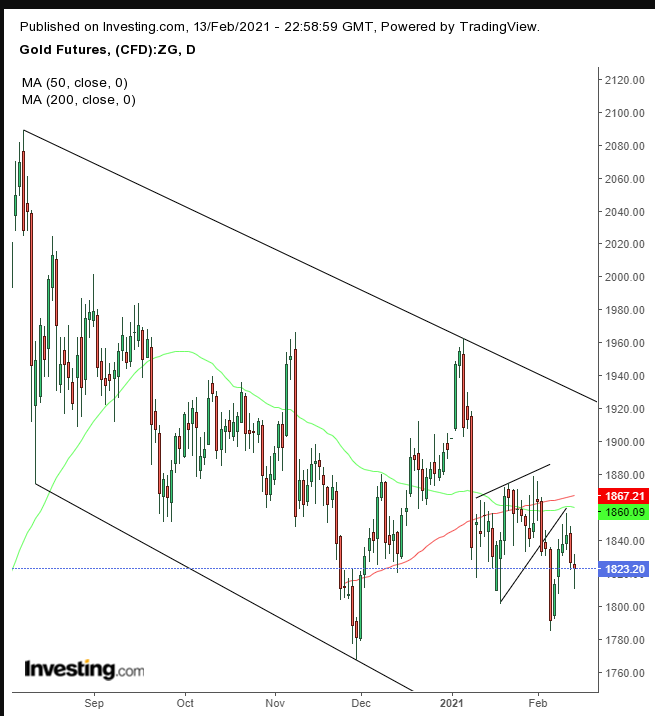- MSCI World Index, S&P 500 registered records on Friday
- 30-year yield reaches 2%, forecasting rising inflation
- Oil just shy of $60 level
- After prices collapsed in the spring and early summer during the worst of the lockdowns—gasoline prices plunged 34% and airfare fell 28% in May— any signs of recovery make it easy for prices to rise.
- Currently, the personal savings rate in the US is high. If restrictions were to ease with the broader vaccine rollout, it’s reasonable to expect relief-spending will ramp up.
- Government spending will likely accelerate as well, even as the Fed keeps the economy lubricated with near-zero rates and a continued supply of QE.
- The sudden shift in demand paradigms, amid lockdowns that necessitated work- and school-from-home, disrupted global distribution supply chains, creating bottlenecks which could limit inventories, increasing prices on suddenly scarce items.
- The Fed’s recent shift from Ben Bernanke’s 2% inflation target in 2012 to a new metric in which average inflation is targeted, allows inflation to run “moderately” above its 2% goal for some time. Since rates have been so low, it would now need to run above 2%, probably around 2.3% over the next three years to compensate for missing the target in the prior three years.
- Markets Closed for Presidents' Day Holiday in the US
- Holidays in Canada, Brazil and Hong Kong as well.
- China's markets closed through Wednesday for the Spring Festival holiday
Stocks extended the late-week rebound to hit a fresh record on Friday, boosted by strong earnings growth. All four major US indices—the Dow Jones, S&P 500, NASDAQ and Russell 2000—finished higher ahead of the weekend. Helping buoy investor optimism: the logistics for vaccine distribution in the US improved, after President Joseph Biden announced his administration had purchased an additional 200 million COVID-19 inoculations.
The MSCI World Equity Index climbed 0.4% on Friday, to a record for the global equity index, advancing for the tenth straight day in a row, gaining 5.9%, in its longest winning streak in years. Risk-on sentiment will likely continue lifting markets into the coming week, even as US inflation and jobs data showed growth had stalled.
Ongoing jobless claims continue to remain substantially higher than pre-pandemic levels which only served to reinforce the case and increase bets for additional stimulus along with the possibility of rising inflation. With no new obstacles in the week ahead on the economic calendar, stock bulls should find little resistance to their slow but dogged charge upward to new ground.
US Equities Score New Records; Inflation Signals Escalate
The S&P 500 scored yet another all-time high on Friday, this time with attitude, ahead of the three-day Presidents' Day holiday weekend, with a solid candle no less, demonstrating trader confidence at being locked into the most expensive equities in history. The SPX gained 1.2% for the week while the Dow rose 1% and the tech-heavy NASDAQ added 1.7% over the same period.
Energy significantly outperformed, (+1.5%), reflecting the rally in oil.
However, not every stock was a winning bet. Online travel company Expedia (NASDAQ:EXPE) released results that showed it had another disappointing quarter. Revenue plummeted 67%, slipping below the psychological billion-dollar level to just $920M—its fourth year-over-year drop in a row.

The stock registered a weekly shooting star, after crossing the downtrend line since the 2017 high, including repeated support at the 200 DMA. The bearish candle developed after nearing the year’s highs.
Along with stocks, Treasury yields, including for the 10-year benchmark note, rose above 1.2% for the first time since March.

The rate provided an upside breakout to a falling flag, bullish after the 20 basis-point surge within 10 days. The flag was the device which enabled rates to slingshot through the Jan. 12 resistance enforced by the shooting star.
Note the upward shift in the rising channel, from the August low, which then accelerates more quickly in November. The 100 DMA traces the original channel, and the 50 DMA (green, so camouflaged) aligned with the bottom of the steeper channel.
But the real bond story was that the 30-year yield reached and closed above 2%, for the first time in a year, setting up the market expectation of a gain for the long bond to its highest level since 2014 when it averaged 3.34% and hit a high of 3.93% during the course of the year.
Is the expectation of rising inflation that's currently part of the market narrative correct? We think so. In our view there are five reasons why:
The dollar rose on Friday after five days of losses.

However, the greenback slipped ahead of the close, giving up almost all of its gains for the day. After the USD found support by an interpretation of one trend line (dotted line), it found resistance by another interpretation of a trend line (red). The dollar closed right on the top of a falling wedge since the March top.
Gold fell for a second day, after the price of the precious metal found resistance by the bottom of a rising flag, for the second day in a row.

The 50 DMA crossed below the 200 DMA, triggering a death cross, amid the flag, bearish after the 7.4% decline in just four sessions and within a falling channel.
Bitcoin fell Saturday for the second day, after hitting a new all-time high above $49K. The most valued cryptocurrency by market cap is now up about 70% for the year. However, at time of writing, it continues to hover below the $50,000 threshold.
A unit of Morgan Stanley Investment Management is the latest mainstream financial firm that has said it's considering adding Bitcoin to its $150 billion growth fund. Still, proceeding with this investment would require approvals from both the investment bank's management and government financial regulators.
Oil surged on Friday, to its highest point since Jan. 7. The price rose to 12 cents below the $60 mark, as predicted by the trading pattern we highlighted at the beginning of February.
The Week Ahead
All times listed are EST
Sunday
18:50: Japan – GDP: expected to drop by more than half QoQ to 2.3% from 5.3% and YoY to 9.5% from 22.9%.
Monday
19:30: Australia – RBA Meeting Minutes
Tuesday
5:00: Germany – ZEW Economic Sentiment: anticipated to slip to 59.5 from 61.8.
8:30: US – Empire State Manufacturing Index: predicted to jump to 6.15 from 3.50.
Wednesday
2:00: UK – CPI: seen to edge down to 0.5% from 0.6% YoY.
3:00: Eurozone – ECB Monetary Policy Statement
8:30: US – Core Retail Sales: to rise to 1.0% rom -1.4% MoM.
8:30: US – PPI: expected to edge higher to 0.4% from 0.3%.
8:30: US – Retail Sales: likely jumped to 1.0% from -0.7%.
8:30: Canada – Core CPI: expected to rise to 0.0% from -0.4%.
14:00; US – FOMC Meeting Minutes
19:30: Australia – Employment Change: predicted to have plunged to 40.0K in January, from 50.0K.
Thursday
7:30: Eurozone – ECB Publishes Account of Monetary Policy Meeting
8:30: US – Building Permits: seen to decline to 1.680M from 1.704M.
8:30: US – Initial Jobless Claims: likely to have slid to 775K from 793K.
8:30: US – Philadelphia Fed Manufacturing Index: to drop to 20.0 from 26.5.
11:00: US – Crude Oil Inventories: previous read was 6.65M bbl.
19:30: Australia – Retail Sales: expected to remain flat at -4.2%.
Friday
2:00: UK – Retail Sales: predicted to drop to -1.6% from 0.3%.
3:30: Germany – Manufacturing PMI: seen to have slipped to 56.5 from 57.1.
4:30: UK – Services PMI: likely to rise to 46.0 from 45.4.
8:30: Canada – Core Retail Sales: to drop to 0.3% from 2.1%.
10:00: US – Existing Home Sales: seen to recede to 6.60M from 6.76M.
